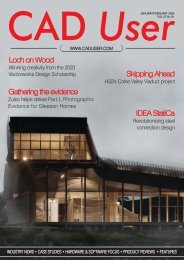CU Jul-Aug 2020
Create successful ePaper yourself
Turn your PDF publications into a flip-book with our unique Google optimized e-Paper software.
CASEstudy<br />
Chasing pavements<br />
A map of pavement widths helps local authorities with social distancing plans<br />
Spatial analysis by Esri UK<br />
has found that 70% of<br />
pavements around the<br />
country are less than 3 metres<br />
wide, making it difficult for<br />
pedestrians to remain 2 metres<br />
apart and follow government<br />
guidelines for social distancing.<br />
Using measurements from<br />
Ordnance Survey, Esri UK has<br />
created a map of all pavement<br />
widths, discovering that only 30%<br />
of Great Britain's pavements are at<br />
least 3 metres wide, 36% are<br />
between 2-3 metres and 34% are less than<br />
2 metres wide.<br />
Esri UK, the mapping and spatial<br />
analytics company, has released the new<br />
map data for free to help the public sector<br />
and other organisations respond to<br />
government guidelines for social<br />
distancing, as councils adapt their<br />
infrastructure to make walking safer for the<br />
public. Over 60 local authorities are using<br />
the new pavement map data including<br />
Glasgow City Council, Stirling Council and<br />
Dover District Council. Measures being<br />
introduced around the country include<br />
widening pavements, removing street<br />
furniture or reallocating road space for<br />
pedestrians.<br />
Oliver Penman, Senior Information Officer,<br />
GCC Corporate GIS, Glasgow City Council,<br />
said "This map is a vital tool to help us find<br />
the right solutions to support social<br />
distancing. Where it may not be feasible or<br />
cost-effective to look at extending<br />
pavement space, we can review other<br />
options such as clamping down on<br />
pavement parking and reducing speed<br />
limits, to cut danger on residential streets."<br />
The map is part of Esri UK's Covid-19<br />
Disaster Response Programme, created to<br />
provide any organisation with new<br />
mapping and analytical capabilities for free,<br />
to help manage their response to the<br />
pandemic. Local authorities, for example,<br />
are using Esri's mapping and analysis tools<br />
to help adjust their service provision, map<br />
vulnerable communities, deploy volunteers<br />
and communicate with citizens.<br />
"The pavement map is designed to help<br />
local authorities and related organisations<br />
prioritise their efforts, to ensure the safety of<br />
the public, as lockdown restrictions are<br />
being gradually eased," said Paul Clarke,<br />
head of Esri UK's Government practice. "By<br />
giving them an instant view of the situation<br />
they're faced with, the map reduces the<br />
time needed to manually measure<br />
pavements and not rely on records which<br />
may be out of date. Easy access to current<br />
pavement width data will help all councils<br />
make faster decisions with greater certainty<br />
and ensure walking is as safe as possible."<br />
Esri UK has made its ArcGIS software free<br />
to use along with a huge free data<br />
repository, the Covid-19 Data Hub, with<br />
over 80 different types of carefully selected,<br />
authoritative location data, including<br />
Coronavirus cases, health, infrastructure<br />
and population data. New data is<br />
continually being added to equip<br />
organisations with valuable insights as the<br />
situation evolves over time. As social<br />
distancing requirements change, for<br />
example, the pavement dataset will be<br />
evolved to meet these changes. Most<br />
importantly, all of the data has been<br />
carefully curated to make sure that it is the<br />
best available from reputable sources.<br />
Esri UK created the Covid-19 Data Hub to<br />
bring a wide range of incredibly<br />
useful datasets together in one<br />
place. The data can be integrated<br />
into existing ArcGIS systems or<br />
used to create a host of brand new<br />
rapid response GIS dashboards<br />
and mobile solutions, specifically<br />
designed for Covid-19 initiatives.<br />
Organisations of all kinds are<br />
turning to geographic information<br />
systems (GIS) to help them make<br />
rapid decisions in this everchanging<br />
and unpredictable world.<br />
Esri's ArcGIS platform provides<br />
them with the dashboards, apps and tools<br />
they need to analyse, forecast and<br />
understand the situation. Yet technology<br />
alone is not enough. Authoritative data is<br />
vital, otherwise the decisions they make<br />
could be flawed.<br />
The map is free to use from Esri UK as<br />
part of its Disaster Response Programme.<br />
Esri UK are able to provide the OS<br />
MasterMap free to Local Authorities as the<br />
data is covered by the PSGA agreement<br />
(Public Sector Geospatial Agreement). The<br />
data can also be made available free to the<br />
private sector, via the Ordnance Survey<br />
Mapping for Emergencies programme.<br />
Esri UK created the new interactive map<br />
using its ArcGIS mapping software, using<br />
the latest MasterMap Topography Layer<br />
from Ordnance Survey (OS). OS<br />
MasterMap Topography Layer is the most<br />
detailed and accurate view of Great<br />
Britain's landscape - from roads to fields,<br />
buildings, trees, fences, paths and more.<br />
Using its GIS software, ArcGIS Pro, Esri UK<br />
extracted all the pavements and applied<br />
different colours to identify different widths.<br />
In the image above represents pavements<br />
of 3+ metres; orange shows widths<br />
between 2-3 metres and red denotes<br />
pavements of less than 2 metres wide.<br />
Local authorities and organisations can<br />
access the pavement map at:<br />
https://bit.ly/2PapBq4<br />
www.arcgis.com<br />
34<br />
<strong>Jul</strong>y/<strong>Aug</strong>ust <strong>2020</strong>

















